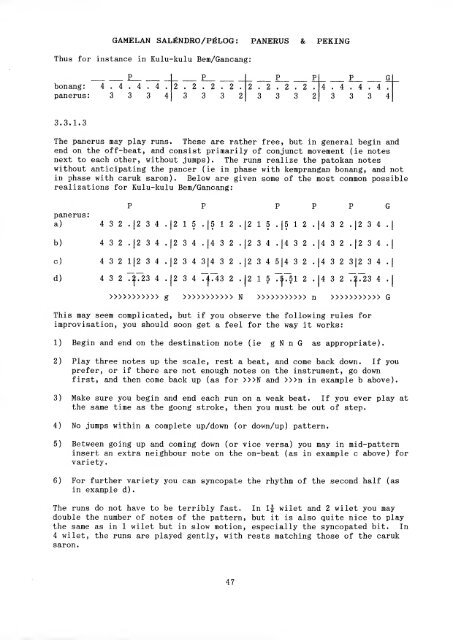Guide to Sundanese Music - Free EBooks Library
Guide to Sundanese Music - Free EBooks Library
Guide to Sundanese Music - Free EBooks Library
You also want an ePaper? Increase the reach of your titles
YUMPU automatically turns print PDFs into web optimized ePapers that Google loves.
GAMELAN SALjgNDRO/PfiLOG : PANERUS & PEKING<br />
Thus for instance in Kulu-kulu Bem/Gancang:<br />
bonang: 4.4.4.<br />
panerus: 3 3 3<br />
3.3.1.3<br />
2.2.2.2.<br />
3 3 3 2 3 3 3 2<br />
P G<br />
4.4.4.4.<br />
3 3 3 4<br />
The panerus may play runs. These are rather free, but in general begin and<br />
end on the off-beat, and consist primarily of conjunct movement (ie notes<br />
next <strong>to</strong> each other, without jumps). The runs realize the pa<strong>to</strong>kan notes<br />
without anticipating the pancer (ie in phase with kemprangan bonang, and not<br />
in phase with caruk saron). Below are given some of the most common possible<br />
realizations for Kulu-kulu Bem/Gancang:<br />
P P P P P G<br />
panerus:<br />
a) 432.|234.|215.(512.|215.j512.|432.|234.|<br />
b) 432.|234.|234.|432.|234.|432.|432.|234.|<br />
c) 4 3 2 1|2 3 4 . |2 3 4 3(4 3 2 .(2 3 4 5|4 3 2 . |4 3 2 3|2 3 4 .|<br />
d) 4 3 2 T|723 4.1234 74743 2 .1215 75751 2 .1432 72723 4 .<br />
>>>>>>>»>> g >>>>>>>>>>> N >>>>>>>>>>> n >>>>>>>>>>> G<br />
This may seem complicated, but if you observe the following rules for<br />
improvisation, you should soon get a feel for the way it works:<br />
1) Begin and end on the destination note (ie g N n G as appropriate).<br />
2) Play three notes up the scale, rest a beat, and come back down. If you<br />
prefer, or if there are not enough notes on the instrument, go down<br />
first, and then come back up (as for >>>N and >>>n in example b above).<br />
3) Make sure you begin and end each run on a weak beat. If you ever play at<br />
the same time as the goong stroke, then you must be out of step.<br />
4) No jumps within a complete up/down (or down/up) pattern.<br />
5) Between going up and coming down (or vice versa) you may in mid-pattern<br />
insert an extra neighbour note on the on-beat (as in example c above) for<br />
variety.<br />
6) For further variety you can syncopate the rhythm of the second half (as<br />
in example d)<br />
The runs do not have <strong>to</strong> be terribly fast. In If wilet and 2 wilet you may<br />
double the number of notes of the pattern, but it is also quite nice <strong>to</strong> play<br />
the same as in 1 wilet but in slow motion, especially the syncopated bit. In<br />
4 wilet, the runs are played gently, with rests matching those of the caruk<br />
saron.<br />
47








